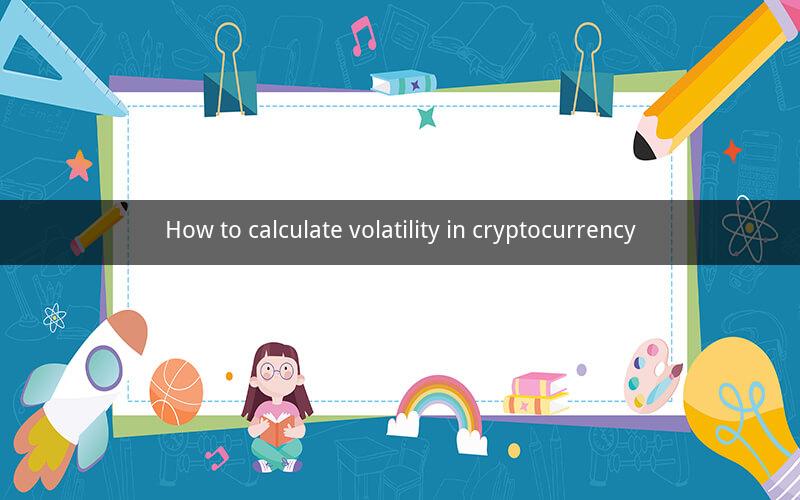
How to Calculate Volatility in Cryptocurrency
Table of Contents
1. Understanding Volatility
2. Types of Volatility
3. Historical Volatility
4. Implied Volatility
5. Volatility Indicators
- Bollinger Bands
- Moving Averages
- RSI (Relative Strength Index)
- MACD (Moving Average Convergence Divergence)
6. Real-Time Volatility
7. Volatility in Different Cryptocurrencies
8. Using Volatility in Trading Strategies
9. Risks and Considerations
10. Conclusion
1. Understanding Volatility
Volatility in the context of cryptocurrency refers to the degree of variation in the trading price of a digital currency over a certain period of time. It is a measure of the risk associated with holding or trading that particular cryptocurrency. Higher volatility indicates a greater chance of price fluctuations, which can be both beneficial and detrimental to investors.
2. Types of Volatility
There are three main types of volatility:
- Historical Volatility: This measures the past price changes of a cryptocurrency and is used to estimate future price movements.
- Implied Volatility: Derived from options trading, it represents the market's expectation of future volatility based on the price of options contracts.
- Real-Time Volatility: This measures the current level of volatility and can be used to make trading decisions in real-time.
3. Historical Volatility
Historical volatility is calculated by taking the standard deviation of the price returns over a specific time period. It provides a benchmark for the amount of price fluctuation a cryptocurrency has experienced in the past.
4. Implied Volatility
Implied volatility is calculated using options pricing models and reflects the market's expectation of future price movements. It is an important metric for options traders and can be used to gauge the market's sentiment towards a cryptocurrency.
5. Volatility Indicators
Several indicators can help traders measure and analyze volatility:
- Bollinger Bands: Consist of a middle band being an N-day moving average, an upper band as the moving average plus two standard deviations, and a lower band as the moving average minus two standard deviations.
- Moving Averages: These are used to smooth out price data over a specified period and can help identify potential volatility levels.
- RSI (Relative Strength Index): This indicator measures the magnitude of recent price changes to evaluate overbought or oversold conditions, which can indicate volatility.
- MACD (Moving Average Convergence Divergence): This indicator shows the relationship between two moving averages and can help identify potential turning points in the price trend, which may indicate increased volatility.
6. Real-Time Volatility
Real-time volatility can be tracked through various exchanges and financial platforms that provide up-to-date price data. Traders can use this information to make informed decisions based on current market conditions.
7. Volatility in Different Cryptocurrencies
Volatility can vary significantly between different cryptocurrencies. Some, like Bitcoin, may have higher volatility due to their market dominance and speculative nature, while others may be more stable.
8. Using Volatility in Trading Strategies
Traders can incorporate volatility into their trading strategies in several ways:
- Day Trading: High volatility can create opportunities for profit in a short time frame.
- Swing Trading: Traders can take advantage of price movements over a few days to weeks.
- Options Trading: Volatility can be a key factor in options pricing and can be used to create strategies such as straddles or strangles.
9. Risks and Considerations
While volatility can present opportunities for profit, it also comes with significant risks:
- Leverage: High volatility can amplify the effects of leverage, leading to rapid gains or losses.
- Market Manipulation: The cryptocurrency market can be prone to manipulation, which can affect volatility levels.
- Regulatory Risk: Changes in regulations can impact the market sentiment and, subsequently, volatility.
10. Conclusion
Calculating and understanding volatility in cryptocurrency is crucial for traders and investors looking to navigate the unpredictable digital asset market. By utilizing various volatility indicators and strategies, one can make more informed decisions and manage risks effectively.
Questions and Answers
Q1: What is the difference between historical and implied volatility?
A1: Historical volatility measures past price changes, while implied volatility reflects market expectations for future price movements.
Q2: Can volatility indicators be used to predict future price movements?
A2: While volatility indicators can provide insights into market conditions, they cannot guarantee future price movements as the cryptocurrency market is highly unpredictable.
Q3: How does leverage affect volatility?
A3: Leverage can amplify the effects of volatility, leading to both significant gains and losses.
Q4: Why is the cryptocurrency market prone to manipulation?
A4: The decentralized and often unregulated nature of the cryptocurrency market can make it susceptible to manipulation by large players or groups.
Q5: How can traders manage risk in a highly volatile market?
A5: Traders can manage risk by setting stop-loss orders, diversifying their portfolio, and staying informed about market trends and regulatory changes.
Q6: Are there any specific cryptocurrencies known for higher volatility?
A6: Cryptocurrencies like Bitcoin and Ethereum are often associated with higher volatility due to their market influence and speculative nature.
Q7: What is the role of Bollinger Bands in volatility analysis?
A7: Bollinger Bands provide a visual representation of volatility levels by showing the standard deviation of price changes around a moving average.
Q8: Can volatility indicators be used for swing trading?
A8: Yes, indicators like RSI and MACD can help traders identify potential entry and exit points for swing trading strategies.
Q9: How does real-time volatility affect trading decisions?
A9: Real-time volatility can help traders make informed decisions based on current market conditions, potentially leading to more successful trading outcomes.
Q10: Are there any legal risks associated with trading cryptocurrencies?
A10: Yes, trading cryptocurrencies can come with legal risks, particularly if the trading is conducted in regions with strict regulations or where cryptocurrencies are considered illegal.